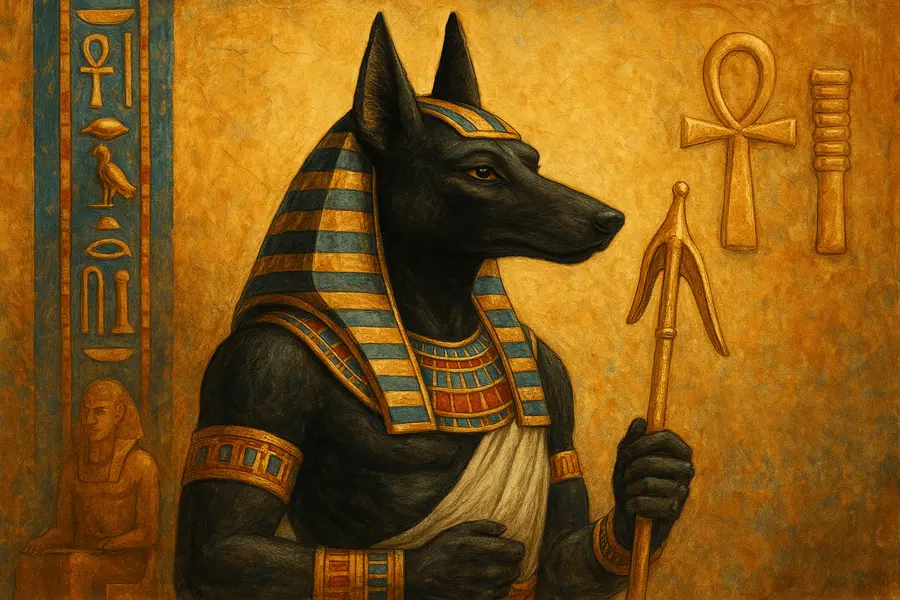Throughout history, dogs have been more than companions — they’ve been guardians, warriors, guides to the afterlife, and sacred messengers. In nearly every major culture, stories featuring dogs reveal their deep spiritual and symbolic importance. From ancient tombs to epic sagas, dogs have played pivotal roles in the mythology and folklore of humanity.
Egypt: Anubis and the sacred canine
In Egyptian mythology, Anubis is one of the most recognized deities — a jackal-headed god associated with mummification and the afterlife. While technically modeled on a jackal, the symbolism closely ties to wild dogs.
Anubis guided souls through the Duat (the underworld), weighed their hearts, and judged their worth. His canine form wasn’t by accident — dogs were seen as guardians of cemeteries and protectors of the spiritual realm. Tomb paintings and funerary objects often featured dogs, especially in the Old and Middle Kingdoms.
Greece and Rome: Cerberus and loyal guardians
The Greek myth of Cerberus — the three-headed dog guarding the entrance to Hades — is one of the most iconic in Western mythology. Described in Hesiod’s Theogony, Cerberus symbolizes vigilance and the insurmountable boundary between life and death.
Romans adopted and adapted many of these beliefs. Dogs were often depicted in funerary art as faithful companions, and Latin epithets like fidelis (faithful) were commonly inscribed near images of dogs on gravestones.
Norse Mythology: Garmr and Hel’s threshold
In Norse sagas, Garmr is a blood-soaked hound who guards the gates of Hel, the realm of the dead. He is prophesied to break free during Ragnarök and battle the god Tyr.
While not as famous as Cerberus, Garmr reflects a similar belief: that a fierce dog must stand between the living and the dead. Some scholars argue that Garmr and Fenrir share mythological origins, representing chaos and the reckoning of time.
China and Japan: Prosperity, loyalty, and divinity
In Chinese culture, the dog is the 11th animal of the zodiac, symbolizing honesty, loyalty, and good fortune. In ancient folklore, dogs were believed to guard against evil spirits — especially during festivals like the Lunar New Year.
Imperial China revered breeds like the Pekingese, which were considered sacred and kept exclusively by nobility. These dogs were believed to carry divine energy and were often buried with their owners.
In Japan, the story of Hachikō, the Akita who waited daily at Shibuya Station for his deceased owner, became a national symbol of loyalty. In 1934, a statue was erected in his honor — and it remains one of Tokyo’s most visited landmarks. Hachikō’s story is taught in schools and continues to inspire books and films.
Indigenous cultures of the Americas
Among various Indigenous peoples, dogs were viewed as spiritual guides and protectors. The Aztecs believed in Xolotl, a dog-headed god who guided souls across the river to the afterlife. Hairless Xoloitzcuintli dogs, named after him, were often buried with the dead to assist in the journey.
In North American First Nations, particularly the Blackfoot and Cree tribes, dogs helped transport goods and acted as hunting companions long before horses were introduced. Their spiritual importance is evident in oral traditions and totemic symbols.
African folklore: divine messengers
In many African societies, dogs are seen as bridges between the seen and unseen worlds. In the Yoruba religion, they accompany the Orisha Ogun, god of war and iron, symbolizing loyalty and guidance in battle.
Among the Ashanti people of Ghana, there are folktales where dogs warn villagers of dangers or expose deceit — acting as moral agents. Some Central African stories speak of dogs as reincarnations of ancestors or guardians of sacred knowledge.
Slavic and Baltic traditions: dogs as protectors of the soul
In Slavic folklore, dogs are thought to see spirits and protect the living from evil. Black dogs, in particular, were both feared and revered. They were believed to detect witches or guard crossroads — a symbolic meeting place between worlds.
In Lithuanian myth, the goddess Laima, associated with fate, was said to be followed by a spirit dog that guided souls into the next life. Dogs were sometimes buried at the threshold of homes to guard the family spiritually.
Celtic beliefs: faithful beyond death
The Celts believed in an afterlife closely intertwined with the natural world. Cú, the Gaelic word for dog, appears in many names and titles, such as Cú Chulainn, the legendary warrior whose name means “Hound of Culann.”
In these tales, dogs often possess supernatural strength, wisdom, or loyalty. White hounds with red ears were said to come from the Otherworld, acting as omens or guides.
What all these legends reveal
Despite regional differences, dogs appear across cultures as symbols of loyalty, guardianship, sacrifice, and connection to the spiritual world. Their roles often reflect humanity’s admiration for qualities like courage, protection, and unconditional love.
They are protectors of boundaries — between life and death, home and danger, the physical and the metaphysical.
Much more than pets: sacred heroes of the human soul
These stories show that dogs are more than beloved animals — they’re part of our spiritual fabric. Across centuries and continents, they’ve been trusted guides, brave defenders, and eternal companions.
In myth, as in life, dogs remain humanity’s most loyal allies.

